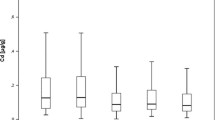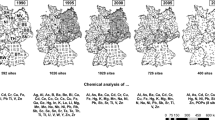Abstract
Goal and Scope. The UNECE heavy metals in Mosses Surveys provide data on the accumulation of metals in naturally growing mosses throughout Europe. Using Germany as an example, this article concentrates on the elaboration and application of methods of data analysis that are necessary for a comprehensive interpretation of spatial and temporal trends in metal accumulation.
Methods and Results. The sampling of mosses, and the chemical analysis of Cr, Cu, Fe, Ni, Pb, Ti, V and Zn in 1990, 1995 and 2000 are summarized briefly. The variogram analyses detect distinct autocorrelation structures in the sample data which may consequently be estimated for all sites in Germany without monitoring metal accumulation by means of ordinary kriging. A procedure for the geostatistical detection of spatial outliers was developed and applied and, after the elimination of the spatial outliers, several measurements were seen to indicate an adequate quality of the geostatistical estimations. The cluster analyses of the z-transformed estimation data result in a nominal multi-element index that indicates regional metal accumulation types over time. Percentile statistics serve for computation of an ordinal, scaled, multi-element accumulation index which is spatially differentiated over time in terms of multivariate, statistically defined ecoregions. The integrative statistical analysis reveals, from 1990 to 2000, that the metal accumulation declines up to 80% in some of the ecoregions. Hot spots of metal accumulation are mapped and interpreted by means of metadata analysis.
Conclusions. Dot maps depict the spatial structure of the metal accumulation without spatial bias. This information, detailed with respect to metal species and space, should be generalized for better supporting the interpretation. The combination of geostatistical analysis and estimation, percentile and multivariate statistics is suitable for the calculation of indices that serve for a comprehensive mapping of metal accumulation in the ecoregions over time, for quantifying the bias of the surface estimation, and for mapping spatial outliers and hot spots of metal accumulation.
Similar content being viewed by others
References
Buse, A., Norris, D., Harmens, H., Büker, P., Ashenden, T., and Mills, G., 2003: Heavy Metals in European Mosses: 2000/2001 Survey, ICP Vegetation Coordination Centre, CEH, Bangor, UK.
Breure, A. M. Markert, B. A. and Zechmeister, H. G. (eds.), 2003: Bioindicators, Biomonitors, Elsevier, Amsterdam.
Fränzle, O., Straskaba, M., and Jorgensen, S. E., 1995: Ecology and Ecotoxicology, Ullmann’s Encyclopedia of Industrial Chemistry, Vol. B7, pp. 19–154.
Gydesen, H., Pilegaard, K., Rasmussen, L., and Rühling, A., 1983: Moss Analyses used as a Means of Surveying the Atmospheric Heavy-Metal Deposition in Sweden, Denmark and Greenland in 1980, Bulletin SNV 1670, Copenhagen.
Herpin, U., Lieth, H., and Markert, B., 1995: Monitoring der Schwermetallbelastung in der Bundesrepublik Deutschland mit Hilfe von Moosanalysen, UBA-Texte 31/95, Berlin.
Markert, B., 1996: Instrumental Element and Multielement Analysis of Plant Samples. Methods and Applications, Wiley, Chichester.
Mucha, H. J., 1984: Clusteranalyse, automatische Klassifikation, in W. Schröder, L. Vetter, and O. Fränzle (eds.), Neuere statistische Verfahren und Modellbildung in der Geoökologie, Vieweg, Braunschweig, Wiesbaden, pp. 109–127.
Olea, R. A., 1999: Geostatistics for Engineers and Earth Scientists, Kluwer Academic Publishers, Boston, Dordrecht, London.
Rühling, A., Rasmussen, L. Mäkinen, A., Pilegaard, K., and Steinnes, E. 1987: Survey of the Heavy-Metal Deposition in the Nordic Countries in 1985 Monitored by Moss Analysis, NORD 1987, 21, Göteborg.
Rühling, A. (ed.), 1994: Atmospheric Heavy Metal Deposition in Europe. Estimations Based on Moss Analysis. NORD 1994, 9, Copenhagen, Stockholm.
Rühling, A., Steinnes, E., and Berg, T., 1996: Atmospheric Heavy Metal Deposition in Northern Europe 1995, NORD 1996:37, Copenhagen.
Rühling, A., and Steinnes, E., 1998: Atmospheric Heavy Metal Deposition in Northern Europe 1995–1996, NORD 1998, 15, Copenhagen.
Schröder, W., Anhelm, P., Bau, H., Matter, Y., Mitze, R., Mohr, K., Peichl, L., Peiter, A., Peronne, T., Pesch, R., Roostai, H., Roostai, Z., Schmidt, G., and Siewers, U., 2002: Untersuchungen von Schadstoffeinträgen anhand von Bioindikatoren: Aus- und Bewertung der Ergebnisse aus dem Moos-Monitoring 1990/91, 1995/96 und 2000/01, 3 Bde., Umweltbundesamt, Berlin.
Schröder, W., and Schmidt, G., 2001: Defining Ecoregions as Framework for the Assessment of Ecological Monitoring Networks in Germany by Means of GIS and Classification and Regression Trees (CART), Gate to EHS 2001, pp. 1–9 [DOI: http://dx.doi.org/10.1065/ehs2001.03.006].
Schröder, W., Schmidt, G., and Pesch, R., 2003: Harmonization of Environmental Monitoring. Instruments for the Examination of Methodical Comparability and Spatial Representativity. In: Gate to Environmental and Health Sciences (http://dx.doi.org/10.1065/ehs2003.07.010).
Siewers, U., and Herpin, U., 1998: Schwermetalleinträge in Deutschland. Moos-Monitoring 1995, Geologisches Jahrbuch, Sonderhefte, Heft SD 2, Stuttgart.
Siewers, U., Herpin, U., and Straßburger, S., 2000: Schwermetalleinträge in Deutschland. Moos-Monitoring 1995, Teil 2, Geologisches Jahrbuch, Sonderhefte, Heft SD 3, Stuttgart.
Stevens, S. S., 1946: On the theory of measurement, Sci. 103, 677–680.
UNECE, 2002: ICP Vegetation Experimental Protocol for the 2001 Season, ICP Vegetation Coordination Centre, CEH, Bangor, UK.
Weber-Blaschke, G., Frieß, H., Peichl, L., and Faulstich, M., 2002: Aktuelle Entwicklungen bei Umweltindikatorensystemen, Umweltwissenschaften und Schadstoff-Forschung — Zeitschrift für Umweltchemie und Ökotoxikologie 14(3), 187–193.
Webster, R., and Oliver, M. A., 2001: Geostatistics for Environmental Scientists, Wiley, Chichester.
Author information
Authors and Affiliations
Corresponding author
Rights and permissions
About this article
Cite this article
Schröder, W., Pesch, R. Integrative Monitoring Analysis Aiming at the Detection of Spatial and Temporal Trends of Metal Accumulation in Mosses. J Atmos Chem 49, 23–38 (2004). https://doi.org/10.1007/s10874-004-1212-0
Accepted:
Issue Date:
DOI: https://doi.org/10.1007/s10874-004-1212-0




